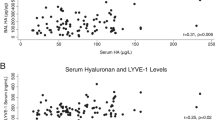Abstract
The development of hepatic veno-occlusive disease following bone marrow transplantation is associated with high-dose combination cytoreductive therapy. Experimental models have suggested that drug-induced injury to hepatic sinusoidal endothelial cells is involved in the pathogenesis of this syndrome. Hyaluronic acid is a polysaccharide that is metabolized, almost exclusively, by hepatic sinusoidal endothelial cells. The aim of the present study was to evaluate serum hyaluronic acid as a marker for endothelial cell injury in patients with veno-occlusive disease following bone marrow transplantation. Hyaluronic acid was measured in sera from patients with and without veno-occlusive disease using an enzyme-linked protein binding assay. Mean peak serum hyaluronic acid levels were significantly greater in patients who had a diagnosis of VOD compared to those transplant patients who did not, 1173.4 ± 982.9 vs 444.9 ± 735.6 ng/ml (P = 0.01). Serial serum samples obtained from a separate cohort of patients also demonstrated that serum hyaluronic acid levels were higher in patients with moderate or severe veno-occlusive disease compared to those with none or mild disease at days 7, 17 and 25 following transplantation (greatest difference at day 25: 366 ± 327 vs126 ± 151, P = 0.01). Serum hyaluronic acid levels are increased in veno-occlusive disease and increase over time in patients with severe disease. Further studies are required to determine if elevated serum hyaluronic acid levels are due to decreased clearance by injured hepatic sinusoidal endothelial cells or increased production from early hepatic fibrogenesis associated with the acute liver injury. Bone Marrow Transplantation (2001) 27, 635–639.
This is a preview of subscription content, access via your institution
Access options
Subscribe to this journal
Receive 12 print issues and online access
$259.00 per year
only $21.58 per issue
Buy this article
- Purchase on Springer Link
- Instant access to full article PDF
Prices may be subject to local taxes which are calculated during checkout



Similar content being viewed by others
References
McDonald GB, Sharma P, Matthews DE et al. Venocclusive disease of the liver after bone marrow transplantation: diagnosis, incidence and predisposing factors Hepatology 1984 4: 116–122
McDonald GB, Hinds MS, Fisher DL et al. Veno-occlusive disease of the liver and multiorgan failure after bone marrow transplantation: a cohort study of 355 patients Ann Intern Med 1993 118: 255–267
Bearman SI . The syndrome of hepatic veno-occlusive disease after marrow transplantation Blood 1995 85: 3005–3020
Shulman HM, Fisher LB, Schoch HG et al. Veno-occlusive disease of the liver after marrow transplantation: histological correlates of clinical signs and symptoms Hepatology 1994 19: 1171–1180
Blostein MD, Paltiel OB, Thibault A, Rybka WB . A comparison of clinical criteria for the diagnosis of veno-occlusive disease of the liver after bone marrow transplantation Bone Marrow Transplant 1992 10: 439–443
Deleve LD . Dacarbazine toxicity in murine liver cells: a model of hepatic endothelial injury and glutathione defense J Pharmacol Exp Ther 1993 268: 1261–1269
Deleve LD, Wang X, Huybrechts MM . Cellular target of cyclophosphamide toxicity in the murine liver: role of glutathione and site of metabolic activation Hepatology 1996 24: 830–837
Ericksson S, Fraser JRE, Laurent TC et al. Endothelial cells are a site of uptake and degradation of hyaluronic acid in the liver Exp Cell Res 1983 144: 223–228
Laurent TC, Laurent UBG, Fraser JRE . Serum hyaluronan as a disease marker Ann Med 1996 28: 241–253
Guechot J, Poupon RE, Poupon R . Serum hyaluronan as a marker of liver fibrosis J Hepatol 1995 22: (S2) 103–106
Guechot J, Loria A, Serfaty L et al. Serum hyaluronan as a marker of liver fibrosis in chronic viral hepatitis C: effect of alpha-interferon therapy J Hepatol 1995 22: 22–26
Nyber A, Engstrom-Laurent A, Loof L . Serum hyaluronidate in primary biliary cirrhosis:a biochemical marker for progressive liver damage Hepatology 1988 8: 142–146
Adams DH, Wang L, Hubscher SG, Neuberger JM . Hepatic endothelial cells: targets in liver allograft rejection? Transplantation 1989 47: 479–482
Fried MW, Connaghan DG, Sharma S et al. Transjugular intrahepatic portosystemic shunt for the management of severe venoocclusive disease following bone marrow transplantation Hepatology 1996 24: 588–591
Shulman HM, Gooley T, Dudley MD et al. Utility of transvenous liver biopsies and wedged hepatic venous pressure measurements in sixty marrow transplant recipients Transplantation 1995 59: 1015–1022
Shulman HM, McDonald GB, Matthews D et al. An analysis of hepatic venocclusive disease and centrilobular hepatic degeneration following bone marrow transplantation Gastroenterology 1980 79: 1178–1191
Richard S, Seigneur M, Blann A et al. Vascular endothelial lesion in patients undergoing bone marrow transplantation Bone Marrow Transplant 1996 18: 955–959
Salat C, Holler E, Kolb H-J et al. Plasminogen activator inhibitor-1 confirms the diagnosis of hepatic veno-occlusive disease in patients with hyperbilirubinemia after bone marrow transplantation Blood 1997 89: 2184–2188
Schuppan D, Farrand A, Oesterling C et al. Circulating markers of hepatic fibrosis predict evolution of veno-occlusive disease after marrow transplantation Hepatology 1997 26: 452A (Abstr.)
Acknowledgements
This study was funded, in part, by a grant from REAADS Medical Products and Chugai Pharmaceuticals. MWF was funded, in part, by a grant from the Carlos and Marguerite Mason Trust Fund. GBM receives funding from the National Institutes of Health, National Cancer Institute, Grant CA 18029 and CA 15704.
Author information
Authors and Affiliations
Rights and permissions
About this article
Cite this article
Fried, M., Duncan, A., Soroka, S. et al. Serum hyaluronic acid in patients with veno-occlusive disease following bone marrow transplantation. Bone Marrow Transplant 27, 635–639 (2001). https://doi.org/10.1038/sj.bmt.1702821
Received:
Accepted:
Published:
Issue Date:
DOI: https://doi.org/10.1038/sj.bmt.1702821
Keywords
This article is cited by
-
Proinflammatory cytokines and their role in the development of major transplant-related complications in the early phase after allogeneic bone marrow transplantation
Leukemia (2003)
-
Veno-occlusive disease of the liver in children with solid tumors undergoing autologous hematopoietic progenitor cell transplantation: a high incidence in patients with neuroblastoma
Bone Marrow Transplantation (2002)



